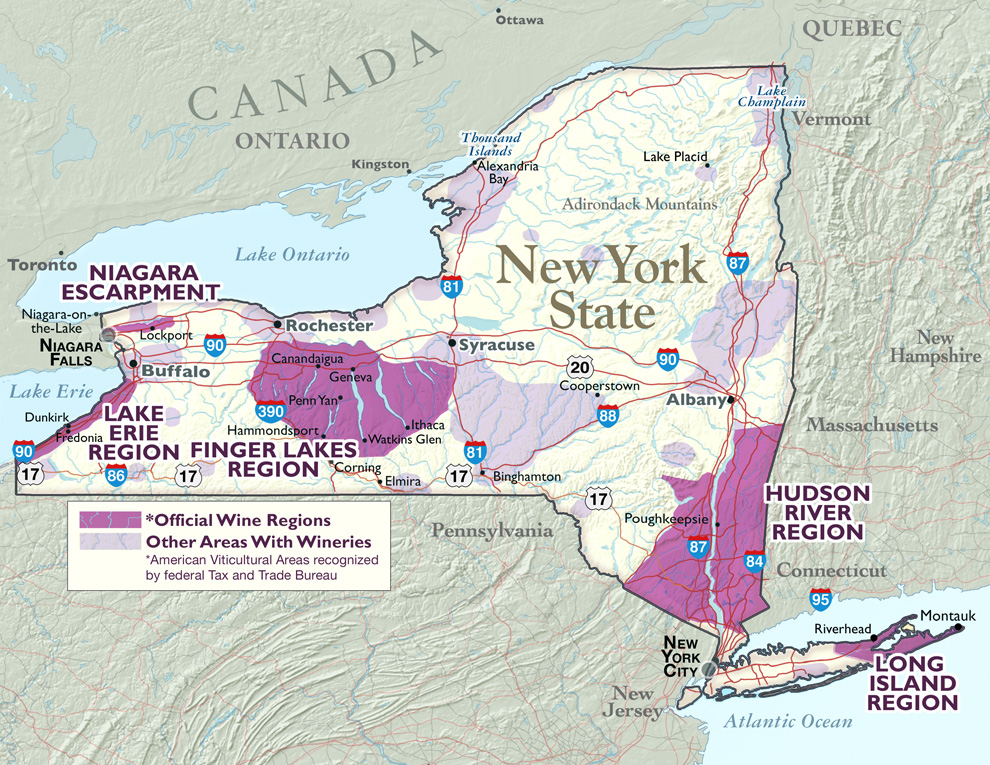WINE, SERIOUSLY Profiles Wine in the Hudson Valley
Viniculture in the Hudson River Region–background
The entirety of the Northeast, including New York State, was once covered by Laurentide ice sheets up to nearly two miles thick during the Late Wisconsin Glacial Period, which receded about 11,000 years ago.[1] As the ice sheet melted it reshaped the landscape beneath it that was to take on the features that we know today, and it helped create the Hudson River Valley, leaving behind a complex and varied topography, soil, and climate–the terroir–, much of it appropriate for vine cultivation or other fruit.
The Hudson River Region AVA is the oldest continually-productive wine region in the United States. Though most people refer to this wine region as the Hudson River Valley or the Hudson Valley, on July 6, 1982 the BATF—in its wisdom—granted the AVA but chose to call it by another name in order to avoid confusion with a winery that already bore the name, Hudson River Valley Winery (no longer in production). If one were to look at different maps that depict the region, its geographical boundaries would not entirely clear, as the maps don’t all agree. (The best one is shown above.) Unfortunately, there is no official AVA map of the region, much less a map for its varied soils and climates. However, it is clearly described verbally in print: its western boundary is the Shawangunk Ridge (a northerly extension of the Appalachians) in Orange and Ulster Counties. It then follows the Delaware River to the New Jersey State line, from which it goes roughly east to its eastern boundary at the state lines with Connecticut and Massachusetts. It then extends north along those borders to the northeast corner of Columbia County, New York. From there it extends west to the juncture of Columbia and Greene Counties in the Hudson River.[2] It includes all or some of several counties: Columbia, Dutchess, Orange, Putnam, Rockland, Sullivan, Ulster, and Westchester.
It doesn’t quite encompass all of the Hudson River Watershed, which extends even further north and includes the Mohawk River (see map at left). From this it can be seen, by comparing it to the first map, that while it is primarily geographic, most of its boundaries are political, which is not unusual for AVAs all over the country; however, it also is not strictly based on a homogenous climate or soil types—the terroir—though many of the vineyards are planted on or near the slopes on either side of the Hudson River.
Soil and Terroir
As can be made out from the soil map above, there is a range of soil that include “acid soils with neutral to acid frangipans” (pink color) that runs the length of the river valley, shifting to “medium to moderately coarse-textured acid soils with strongly acidic frangipans on glacial till from gray slate, sandstone, [and] slate” (red color). Contiguous to this is also “deep and shallow soils associated with hilly areas” (dark red). Along the mid to upper-length of the river we see “moderate to fine-textured soils on glacial lake or marine sediments” (pale blue). At the southern limits we see “muck” (dark blue, highly fertile) and “moderately coarse textured, very strongly acid soils from glacial till from granite” (brown color). As grapevines are not fond of acidic soils, this means that many if not most vineyards need alkaline additions such as lime to bring up the soil pH.
The most complete and accessible description of the soils and terrains of the Region may be that of the “New York Wine Course and Reference”, which is worth quoting at length:
A further explanation makes even more clear just how complex the soil profiles of the Region comes from the USDA soil series page:
Indeed, it is the Hudson , with its moderating effect on climate, thanks to the tidal flow and winds that sweep upriver from the Atlantic as well as the so-called “lake effect” (or “river effect” in this case–except in the winter, if the river freezes and is covered with ice) of its wide, deep, flowing stream, that make it possible to grow grapes at all, as it would otherwise be too frigid for most varieties other than the native ones. Its growing season is short: 180 to 195 days. (By comparison, Long Island’s season lasts from 215 to 230 days, while the Niagara Escarpment enjoys 205 days, and the Finger Lakes AVA has 190 to 205 growing days.) Its production is also small, at 585 tons a year (about 2.5 tons an acre), whereas the Niagara Escarpment, with only 6 vineyards and 883 acres produces 4,648 tons (about 5 tons an acre), though some of this is for table grapes, which have much higher yields than do wine grapes.[7]
Read the whole thing at:
http://blogwine.riversrunby.net/viniculture-in-the-hudson-river-region-background/2014/03/14/






0 Comments:
Post a Comment
Subscribe to Post Comments [Atom]
<< Home